
The family Cisticolidae is a group of about 160 warblers, small passerine birds found mainly in warmer southern regions of the Old World. They were formerly included within the Old World warbler family Sylviidae.

The bar-throated apalis is a small African passerine bird belonging to the genus Apalis of the family Cisticolidae. It is native to the eastern and southern Afrotropics.

The apalises are small passerine birds belonging to the genus Apalis, in the family Cisticolidae. They are found in forest, woodlands and scrub across most parts of sub-Saharan Africa. They are slender birds with long tails and have a slender bill for catching insects. They are typically brown, grey or green above and several species have brightly coloured underparts. Males and females are usually similar in appearance but the males are sometimes brighter.

The eremomelas are a genus, Eremomela, of passerines in the cisticola family Cisticolidae. The genus was previously placed with the larger Old World warbler family Sylviidae prior to that genus being broken up into several families. The genus contains eleven species, all of which are found in sub-Saharan Africa. They occupy a range of habitats, from arid scrub to lowland tropical forest. They are intermediate in appearance between crombecs and apalis, and measure between 8.5 to 12 cm (3.3–4.7 in) in length. The sexes are alike in size and plumage.

The lowland masked apalis, also known as the masked apalis, is a species of bird in the family Cisticolidae. It is found in Angola, Cameroon, Democratic Republic of the Congo, Equatorial Guinea, Gabon, Tanzania, and Uganda. Its natural habitats are subtropical or tropical dry forest and subtropical or tropical moist lowland forest.

The Chirinda apalis is a species of passerine bird belonging to the family Cisticolidae. This species is endemic to the Eastern Highlands of Zimbabwe and Mozambique. Its natural habitats are subtropical or tropical moist lowland forest and subtropical or tropical moist montane forest.
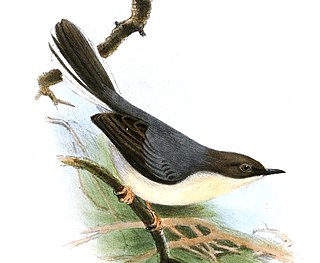
The grey apalis is a species of bird in the family Cisticolidae.
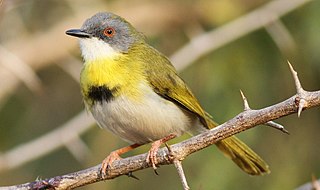
The yellow-breasted apalis is a species of bird in the family Cisticolidae.

The yellow-throated apalis is a passerine bird in the family Cisticolidae. It is endemic to Malawi. It was formerly considered a subspecies of the bar-throated apalis.

The black-throated apalis is a species of bird in the family Cisticolidae. It is native to the Western High Plateau, the Albertine Rift montane forests and the east African montane forests and isolated lowland areas of Cameroon, the DRC and Angola.
The Karamoja apalis is a species of bird in the family Cisticolidae. It is found in Tanzania, Uganda and Kenya.

The black-headed apalis is a species of bird in the family Cisticolidae. It is found in Kenya, Malawi, Mozambique, Somalia, Tanzania, and Zimbabwe. Its natural habitats are subtropical or tropical dry forest, subtropical or tropical moist lowland forest, and subtropical or tropical moist montane forest.
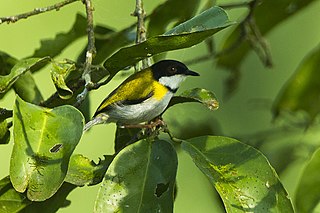
The black-capped apalis is a species of bird in the family Cisticolidae. It is sparsely distributed throughout the tropical rainforest of Sub-Saharan Africa.

The chestnut-throated apalis is a species of bird in the cisticola family Cisticolidae. The Kabobo apalis, originally described as a distinct species, is usually treated as a subspecies A. p. kaboboensis of the chestnut-throated apalis today. It is itself sometimes considered to be the same species as the Chapin's apalis.
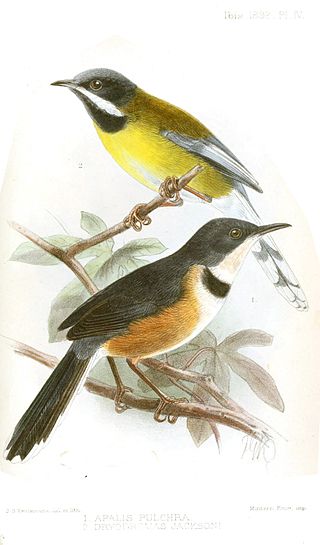
The black-collared apalis is a species of bird in the family Cisticolidae. It is found in the Cameroonian Highlands forests, western Kenya and the Albertine rift montane forests.
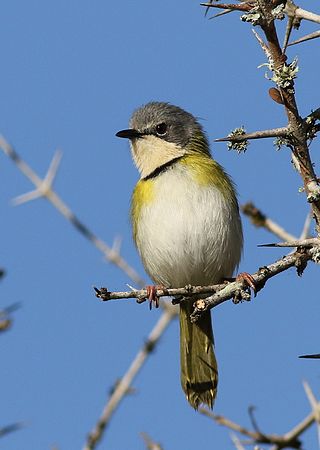
Rudd's apalis is a species of bird in the family Cisticolidae. It is found primarily in Mozambique but also in southern Malawi and adjacent areas of South Africa and Eswatini. Its natural habitats are subtropical or tropical dry forest and subtropical or tropical moist shrubland.

The buff-throated apalis is a species of bird in the family Cisticolidae. It is found in Angola, Benin, Burundi, Cameroon, Central African Republic, Republic of the Congo, Democratic Republic of the Congo, Equatorial Guinea, Gabon, Kenya, Nigeria, Rwanda, South Sudan, Tanzania, Uganda, and Zambia.
The Rwenzori apalis or collared apalis is a species of bird in the family Cisticolidae. It is found in Burundi, Democratic Republic of the Congo, Rwanda, and Uganda. Its natural habitat is subtropical or tropical moist montane forest.

The red-fronted prinia, also known as the red-fronted warbler and the red-faced apalis, is a species of bird in the family Cisticolidae. It is found in Chad, Djibouti, Eritrea, Ethiopia, Kenya, Somalia, Sudan, Tanzania, and Uganda. Its natural habitat is dry savanna.
The brown-headed apalis is a small passerine bird belonging to the genus Apalis in the family Cisticolidae. Formerly included within the grey apalis but is now commonly considered to be a separate species. It has two subspecies: A. a. alticola and A. a. dowsetti

















